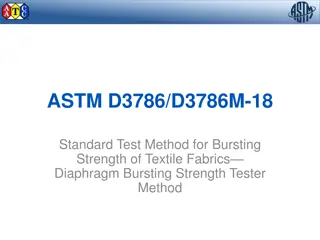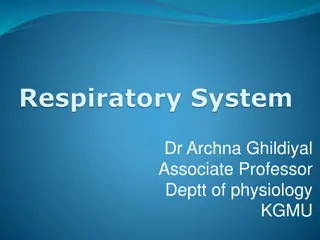Liver Transplant in India for treatment
Liver is the largest gland in our body, and an important metabolic organ which carries out many essential biological functions. The liver is a wedge-shaped, reddish-brown in color with two lobes of different size and shape. The approximate weight of a human liver is 1.5 kilograms. It is in the upper
5 views • 2 slides
Anatomy of the Diaphragm: Structure, Function, and Clinical Relevance
The diaphragm, a key muscle of respiration, separates the thoracic and abdominal cavities and plays a crucial role in breathing. This dome-shaped musculofibrous partition originates from various structures such as the xiphoid process, lower ribs, and lumbar vertebrae. Its actions are essential for t
1 views • 29 slides
Theory of Positive Displacement Pumps: Reciprocating Pumps
Reciprocating pumps, including piston, plunger, and diaphragm pumps, play a crucial role in various industries. This chapter delves into the operating principles of reciprocating pumps, focusing on their capacity and design considerations. Explore the concepts and components that determine the perfo
0 views • 79 slides
Understanding Automobile Transmission Systems: Construction and Functions
Automobile transmission systems consist of components like the clutch, gearbox, propeller shaft, and differential, working together to transmit power from the engine to the wheels. The clutch engages and disengages power smoothly, while the gearbox adjusts torque and speed based on road conditions.
0 views • 22 slides
Measurement Methods for Pressure Evaluation
The content describes the measurement of pressure using various methods such as Bourdon pressure gauge, diaphragm pressure gauge, and McLeod gauge. It explains the principle of McLeod vacuum gauge, the operation of the gauge, and the components involved. The McLeod gauge works by compressing a known
2 views • 27 slides
Understanding Pressure Measurement and Hydrostatic Forces on Surfaces
Measurement of pressure using various gauges like Bourdon and Diaphragm Gauge, different types of pressure gauges like Bellows and Dead Weight Pressure Gauge are discussed. Piezometer and different types of manometers for pressure measurement are also explained. Additionally, the concept of hydrosta
2 views • 11 slides
Root Development in Tooth Growth Process
Root formation plays a crucial role in the development of teeth, starting after enamel and dentin formation at the cementoenamel junction. Hertwig's epithelial root sheath (HERS) molds the shape of roots, initiating radicular dentin formation. The cervical loop forms an epithelial diaphragm, narrowi
0 views • 23 slides
ASTM D3786/D3786M-18 Standard Test Method for Bursting Strength of Textile Fabrics
This standard test method, ASTM D3786/D3786M-18, specifies the procedure for determining the bursting strength of textile fabrics using a diaphragm bursting strength tester. The test involves clamping the specimen over an expandable diaphragm and applying pressure until the fabric ruptures. The burs
0 views • 16 slides
Understanding the Respiratory System and its Vital Functions
The respiratory system plays a crucial role in our bodies by taking in oxygen and expelling carbon dioxide. Key components include the lungs, diaphragm, bronchi, and alveoli. Air enters through the nose or mouth, travels down the trachea to the lungs, where oxygen is absorbed into the bloodstream an
0 views • 26 slides
Anatomy of GI Rectum and Anal Canal: A Detailed Visual Guide
This visual guide showcases detailed images of the gastrointestinal (GI) rectum and anal canal anatomy, including structures such as the perineum, pelvic diaphragm, external and internal anal sphincters, and various junctions within the rectum. Each image provides a clear depiction of the anatomical
0 views • 6 slides
Understanding the Mediastinum: Boundaries, Divisions, and Contents
The mediastinum is a critical anatomical region in the thoracic cavity that houses various structures like the heart, thoracic vertebrae, diaphragm, and sternum. Divided into superior and inferior sections, it contains essential organs, vessels, nerves, and lymph nodes. Understanding its boundaries,
0 views • 25 slides
Understanding Perineal Hernias in Veterinary Surgery
Perineal hernias are a common condition in uncastrated males but can also occur in females and cats. Weakness in the pelvic diaphragm can lead to herniation due to factors like hormonal disorders, prostatic diseases, and rectal issues. The symptoms include swelling in the perineal region, and diagno
0 views • 25 slides
Fetal Pig Dissection Lab: Observing External Features and Respiratory System
In this detailed lab report on fetal pig dissection, students are tasked with observing the external features of the pig, determining its gender, examining teeth and skin, and studying the importance of the umbilical cord. The lab also delves into the respiratory system, focusing on cartilage rings,
0 views • 24 slides
Mechanics of Pulmonary Ventilation and Respiratory Cycle Explained
Understanding the mechanics of pulmonary ventilation is crucial for comprehending the breathing process. This comprehensive overview covers the role of muscles, ribs, pressure changes in alveolar, pleural, and transpulmonary regions, terms related to breathing and ventilation, and the contraction an
0 views • 31 slides
Understanding the Thoracic Cage and Respiratory Movements in Anatomy Lecture
Professor Ahmed Fathalla Ibrahim, a renowned Professor of Anatomy at King Saud University, covers the components of the thoracic cage, articulations, respiratory movements, and muscles involved in breathing in this informative lecture. Learn about the structure of the thoracic cage, articulations li
0 views • 24 slides
Understanding Hiatal Hernia and Irritable Bowel Syndrome (IBS) for Adult Nursing
A hiatal hernia involves the protrusion of the stomach through the diaphragm, leading to various types and complications. Symptoms may include heartburn and dysphagia, diagnosed through barium studies and endoscopic exams. Management includes lifestyle changes, medication, and surgical repair. Nursi
0 views • 15 slides
Virtis/Opis Technical Updates and Releases Over the Years
Explore the evolution of Virtis/Opis software through various releases starting from Opis R/C Superstructure LRFD Analysis in 6.0 release to the addition of new features and enhancements in subsequent versions like the Superstructure Wizard Analysis Control Settings and Diaphragm Wizard in the fall
0 views • 32 slides
Understanding the Respiratory System and Importance of Breathing
Explore the intricacies of the respiratory system, how breathing sustains life by delivering oxygen to cells, and the journey of air from the nose to the lungs. Discover how the diaphragm and other muscles facilitate breathing, enabling the exchange of oxygen in the air sacs for the bloodstream. Gra
0 views • 13 slides
Understanding Female Pelvis Anatomy and Differences from Male Pelvis
The female pelvis anatomy lecture covers the pelvic wall, bones, joints, and muscles. It explains the boundaries, subdivisions, and types of female pelvis, along with details on pelvic walls, floor, and diaphragm components. Additionally, it includes information on arterial, nerve, lymph, and venous
0 views • 13 slides
Dynamic Calibration of Pressure Transducers in a Shock Tube
This study focuses on the dynamic calibration of pressure transducers in a shock tube to understand boundary layer stability and transition. By creating a shock to impact a Kulite pressure transducer mounted at the end of the tube, researchers aim to determine key parameters such as resonance, dampi
0 views • 11 slides
Understanding the Respiratory System and the Process of Respiration
The respiratory system is vital for breathing as it helps in the exchange of oxygen and carbon dioxide. This system consists of organs such as the lungs, bronchi, and alveoli. The process of respiration involves inhaling air through the nose or mouth, passing it through the trachea and bronchi into
0 views • 5 slides
Understanding the Importance of Breathing and Respiratory System
Breathing plays a crucial role in delivering oxygen to the body and removing carbon dioxide. The respiratory system, including the lungs, trachea, bronchi, and alveoli, functions to facilitate this vital process. The diaphragm muscle helps in inhaling and exhaling, while the exchange of oxygen and c
0 views • 14 slides
Solving Mechanical Problems in Industrial Systems
Explore the intricacies of mechanical systems maintenance including bearings, pumps, piping, hoses, and more. Dive into the world of centrifugal, rotary, gear, reciprocal, and diaphragm mechanisms. Learn about maintaining triplex mud pumps, important checks for power sources, and common maintenance
0 views • 20 slides
Enhancing Pharmaceutical Process Reliability with JorlonTM Diaphragms
Aseptic valve components are crucial in the pharmaceutical industry, especially the diaphragms in automated control valves. JorlonTM Diaphragm, a pure PTFE material, provides a sterile barrier, increasing valve life and reducing downtime risks due to failures. Tested for durability, JorlonTM offers
0 views • 16 slides
Exploring the Components of a Light Microscope in Basic Sciences at University of Basrah College of Dentistry
In this lab session led by Dr. Hanaa Ali Hussein, students learn about the essential parts of a light microscope, including the ocular lens, body tube, prism, arm, resolving nose piece, objective lens, mechanical stage, adjustment knobs, illuminator, base, condenser lens, iris diaphragm, and light f
0 views • 10 slides
Exploring the Human Respiratory System Structures
Delve into the intricate structures of the human respiratory system, from the essential organs like the lungs and diaphragm to the pathways such as the nasal cavity, mouth, pharynx, and trachea. Learn about the functions of key components like the epiglottis, larynx, bronchi, bronchioles, and alveol
0 views • 12 slides

























